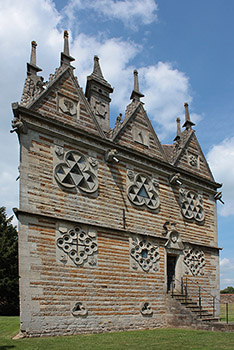 |
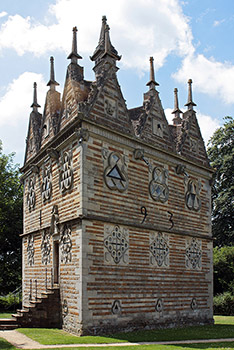 |
|
| South East side with number 15 | North face with number 93 | |
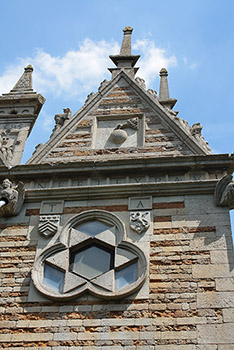 |
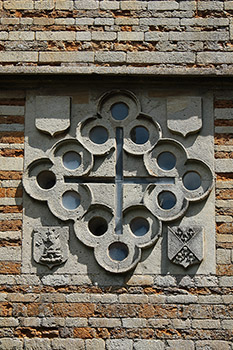 |
|
| South West side gable | A middle storey window | |
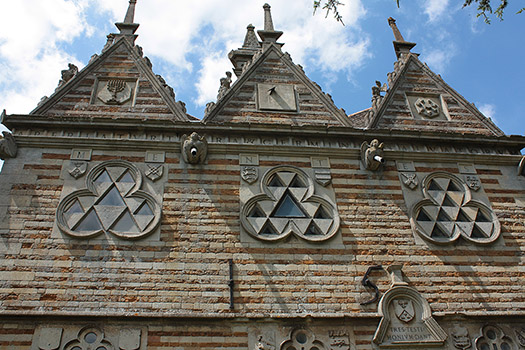 |
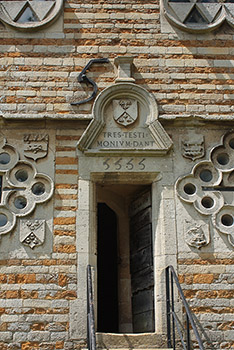 |
|
| Trefoil windows above the door on the SE side | The door |
 |
 |
|
| South East side with number 15 | North face with number 93 | |
 |
 |
|
| South West side gable | A middle storey window | |
 |
 |
|
| Trefoil windows above the door on the SE side | The door |
Rushton Lodge lies just NW of Kettering and east of Desborough. If you are travelling from the M1 to East Anglia along the A14 a visit involves only a short detour. It is now administered by English Heritage.
The Lodge was built by Sir Thomas Tresham. He was knighted by Elizabeth I at Kenilworth in 1575. However, as a Catholic he was subject to fines for recusancy and between 1581 and his death in 1605 paid almost £8,000 and on his death had debts of £11,000. Sir Thomas was imprisoned for harbouring Father Edmund Campion, a Catholic priest. Also imprisoned were his two brothers-in-law, William, 3rd Baron Vaux of Harroden and Sir William Catesby of Lapworth. He was imprisoned or under house arrest from August 1581 to April 1593, for a few months in 1594 and again in late 1597 and early 1598. In 1593, Tresham began the design and construction of the lodge, ostensibly as a home for his warrener, the man who looked after the rabbits. Building started on 28 July 1594 and was completed at the end of the following year. Detailed account were kept by Tresham's steward George Levens and they are now in the British Museum.
The Lodge is full of Catholic symbolism, some of it not yet deciphered but the recurrent use of the number three relates to the Trinity. It has three sides, each of three storeys and each storey has three windows. The walls are 33 feet long and each side has a Latin text of 33 letters. The SW side has TT for Thomas Tresham in iron letters. The other two have 15 and 93 for the date 1593. The three sides face north, south-east and south-west with the door in the south-east side.
The best accessible source of information on the Lodge is the 28 page brochure produced by English Heritage available at the site. A description is given on Wikipedia but with less detailed pictures than shown above. There are also some pictures accessible from Google Street View.
Sir Thomas also began in 1594 the construction of Lyveden New Bield but he died before it was finished. It is shaped as a cross. It is now a National Trust propery. He was also responsible for the Market House in Rothwell, built in 1578. This has no religious symbolism but is rich in heraldry. His main residence, Rushton Hall, dated from his grandfather's time and the west range, dating from this period, still survives.
Sir Thomas Tresham's son, Francis was involved in the Gunpowder Plot against King James I. The story of the plot is too long and complicated to relate here. It needs to be seen against the background of the earlier plots against Elizabeth I. Many of the participants in the Gunpowder Plot had been involved in the Essex Rebellion. Even now the subject remains controversial. Catholic authors such as Lady Antonia Fraser take a more sympathetic line towards the plotters than authors of a non-sectarian perspective. However, what is remarkable about the Gunpowder Plot, in the context of the Treshams, is how closely many of the plotters were connected by blood and marriage. Below is a summary of the connections between the Throckmortens, Wintours, Treshams, Catesbys and other significant characters in the story including Lord Monteagle and Lord Stourton; the plotters are shown in bold type. Given their family connections and previous form as conspirators they could hardly be described in modern anti-terrorism parlance as "clean skins". Francis Tresham's two brothers-in-law, Lord Stourton and Lord Monteagle would have been victims of a successful explosion at the Houses of Parliament when all the lords and MPs were present for the opening of parliament. It is likely that Tresham, one of the last people recruited into the plot, arranged to tip them off and this led to the famous Monteagle letter which allowed Lord Monteagle to disclose the plot to the authorities. Tresham was arrested and imprisoned and died soon afterwards on 22 December 1605. He escaped trial but his corpse was beheaded and the head exhibited on the gates of Northampton.
As a consequence of his involvement in the plot, Sir Francis Tresham's assests, such as they were, went to the crown but most of the estate passed to his younger brother, Lewis, created baronet in 1611. At that time baronetcies were sold by James I to raise money for the Protestant settlement of Ireland. Lewis sold the estate in 1614 to one of his creditors, Sir William Cockayne, a London money lender. The Cockaynes obtained the viscountcy of Cullen in 1642. They enlarged the main house but eventually sold it 1828 to William Hope. Subsequently it passed through the Clarke-Thornhill and Paine families and in 1984 Mr. G. H. Paine transferred the Lodge to the Ministry of Works which eventually became, English Heritage.
Some of the other plotters were also related to each other. Robert Keyes was a cousin of Elizabeth Tyrrwhitt who married Ambrose Rookwood. Martha Wright, sister of Jack and Christopher Wright married Thomas Percy.
Rushton Triangular Lodge, edited by Sarah Yates, designed by Pauline Hull with photography by Steve Cole and Jonathan Bailey, plans by Richard Morris and production by Elaine Poole for a brochure by English Heritage, ISBN 1 85074 819 5